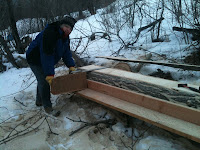06 24 11 Not Waste
One of the premises of permaculture is that there is no such thing as waste. All waste is a resource for some other organism or process in the ecosystem. Although this is generally true, it is also true that learning how to use every resource can be a challenge. Such has been the case with our cottonwood trees.
When we bought our bioshelter home we made a list of pros and cons. The cottonwoo ds fell on the “con” list. We lived in a cottonwood grove before we moved, and had already learned that both of us were allergic to cottonwoods. And as if living with stuffy noses was not enough, the cottonwoods added insult to injury by constantly dropping junk in the yard that had to be picked up. There were sticky husks tracked in the house following the emergence fo the leaves, followed by blowing cotton that inevitably was sucked into the garage, followed by sticky seed pods, followed by branches that inevitably broke off in a windstorm.
ds fell on the “con” list. We lived in a cottonwood grove before we moved, and had already learned that both of us were allergic to cottonwoods. And as if living with stuffy noses was not enough, the cottonwoods added insult to injury by constantly dropping junk in the yard that had to be picked up. There were sticky husks tracked in the house following the emergence fo the leaves, followed by blowing cotton that inevitably was sucked into the garage, followed by sticky seed pods, followed by branches that inevitably broke off in a windstorm.
The cottonwoods seemed more trouble than they were worth. But if we wanted the bioshelter, the cottonwoods came with them.
Last winter we decided to replace the cottonwoods with some sub-arctic fruit trees. We already had a good growth of high bush cranberries, rose hips and currents for the shrub level of our forest garden, but we decided it well worth the effort to replace the cottonwoods that formed the canopy of the forest with something that better added to our sustainable life. So I started cutting cottonwoods.
The problem at that point was what to do with all the cottonwood and sticks we were harvesting. We started out cutting it into firewood rounds for heat. Quite honestly, cottonwood makes lousy firewood. Most of the mass in a new-cut cottonwood is water. They are like sponges and so the green logs weigh a ton. But once they dry out they are very lightweight and burn like paper. It takes a huge amount of cottonwood to heat the masonry in our masonry heater.
Then we saw a YouTube rendition on a do-it-yourself sawmill. Basically, it consists of two 2X10s screwed together at a right angle and attached to the length of the log. A chainsaw is crewed into a rectangular box, and pushed down the guide sawing off planks (see photo).
At the same time, we knew that we needed more vegetable boxes if we were to grow enough vegetables to become more sustainable. The plan was to build boxes all along the edge of our deck. Why not make our own lumber to use in making the boxes? We were so taken by the idea that I put some 2X10s together and we started sawing our own lumber.
more sustainable. The plan was to build boxes all along the edge of our deck. Why not make our own lumber to use in making the boxes? We were so taken by the idea that I put some 2X10s together and we started sawing our own lumber.
The Christian faith tradition has always taught that all things honor (praise) God just by being themselves. All things serve God’s purpose in creation, and humans are called to find great joy just in witnessing this reality.
For me, this is a helpful lesson. As frustrated as I have sometimes been with cottonwoods, that frustration largely comes from my own desires for personal convenience. Cottonwoods are wonderful, too. Even the branches make fabulous wood chips, which are so helpful in gardening, and in building soil for the future. Even so, this doesn’t make me any less happy to help our property transition from a cottonwood forest to fruit trees.



Comments
Post a Comment